





Yes dear reader, I offer you a new hike today, so start warming up.
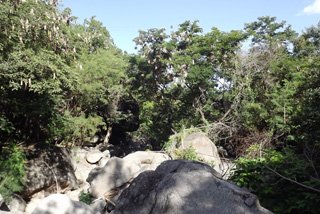 Good! I see a couple readers who have left their keypad and grabbed a backpack; they are ready to go so let us hit the rocks! Yes, you may hit some rocks if you wander mindlessly in the place I am taking you to, a pretty rocky one as you will discover. Ravine du trou ("hole ravine") is one of those many gullies dug by heavy cyclonic downpours million of years ago; it will fill during those tropical storms and be bone dry the rest of the year. No worry, we are now in austral winter when hurricanes do not build up, as the ocean waters are not warm enough. The ravines on the western coast are usually pretty dry with an occasional spring bringing an oasis-like atmosphere. The rather dry environment has allowed many species adapted to such conditions and though trees never reach great heights they still grow vigorously.
Good! I see a couple readers who have left their keypad and grabbed a backpack; they are ready to go so let us hit the rocks! Yes, you may hit some rocks if you wander mindlessly in the place I am taking you to, a pretty rocky one as you will discover. Ravine du trou ("hole ravine") is one of those many gullies dug by heavy cyclonic downpours million of years ago; it will fill during those tropical storms and be bone dry the rest of the year. No worry, we are now in austral winter when hurricanes do not build up, as the ocean waters are not warm enough. The ravines on the western coast are usually pretty dry with an occasional spring bringing an oasis-like atmosphere. The rather dry environment has allowed many species adapted to such conditions and though trees never reach great heights they still grow vigorously.
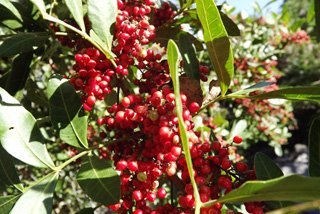 One reason I have to walk up this ravine is for harvesting seeds, one of my many occupations. Today we are hunting for Schinus terebinthifolius, a member of the Anacardiaceae family known locally as 'baies roses', 'encens' or 'faux poivrier', and Brazilian pepper or rose pepper in English-speaking countries. This tree originates from Brazil and has spread in the wild here. It can grow in full sun in very rocky areas and produces masses of bright red fruits which have a nice peppery taste and give an interesting aroma to dishes and smoked fish. This species is highly invasive as it can adapt to a very wide range of growing conditions, from dry areas like where we are to even swampy ones.
One reason I have to walk up this ravine is for harvesting seeds, one of my many occupations. Today we are hunting for Schinus terebinthifolius, a member of the Anacardiaceae family known locally as 'baies roses', 'encens' or 'faux poivrier', and Brazilian pepper or rose pepper in English-speaking countries. This tree originates from Brazil and has spread in the wild here. It can grow in full sun in very rocky areas and produces masses of bright red fruits which have a nice peppery taste and give an interesting aroma to dishes and smoked fish. This species is highly invasive as it can adapt to a very wide range of growing conditions, from dry areas like where we are to even swampy ones.
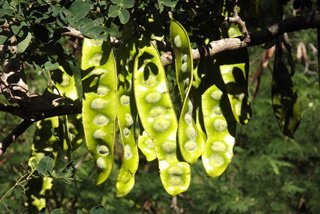 We of course will take advantage of his harvest to check if other interesting species are worth a stop or estimate when ripening fruits will be fine for picking. Anyway, we drive a short time and park the car by the road, as we came from the south the ocean is on our left and on the right opens the ravine. The best way is to first walk across the asphalt towards the waves then under the bridge and we hit the trail. Not a very frequented one as you will soon discover, small herds of goats with a shy shepherd or wasps hunters are the only folks you may encounter here. And the occasional wet-back seeds gatherer...
We of course will take advantage of his harvest to check if other interesting species are worth a stop or estimate when ripening fruits will be fine for picking. Anyway, we drive a short time and park the car by the road, as we came from the south the ocean is on our left and on the right opens the ravine. The best way is to first walk across the asphalt towards the waves then under the bridge and we hit the trail. Not a very frequented one as you will soon discover, small herds of goats with a shy shepherd or wasps hunters are the only folks you may encounter here. And the occasional wet-back seeds gatherer...
W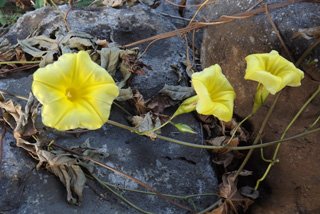 atch your step--rocks seem to inflate as we start up the gully until we soon have to switch from walking to climbing. There are already Brazilian pepper trees, they grow between two large boulders or cling to crumbling sides with roots like tentacles. We may pick a bagful of fruits, they are fully ripe and will only need a further drying before packing, just leave the bag here, we can catch it on the way back down. Climbing soon resumes as the gully opens up a little and becomes a rather easy walk now. The handsome trees growing on this spot are Albizzia lebbeck, a common member of the Fabaceae family which has spread on the island. They are very suited to the harsh conditions and may turn into trees several meters tall. Pods seem pretty healthy and should be fine within one or two months unless they fall prey to caterpillars. When those fruits are fully ripe they turn golden yellow and the winds turn them into natural wind chimes, thus giving open air concert to anyone present. If we add that the flowers give off a deliciously sweet smell I am sure you will love those trees as much as I do!
atch your step--rocks seem to inflate as we start up the gully until we soon have to switch from walking to climbing. There are already Brazilian pepper trees, they grow between two large boulders or cling to crumbling sides with roots like tentacles. We may pick a bagful of fruits, they are fully ripe and will only need a further drying before packing, just leave the bag here, we can catch it on the way back down. Climbing soon resumes as the gully opens up a little and becomes a rather easy walk now. The handsome trees growing on this spot are Albizzia lebbeck, a common member of the Fabaceae family which has spread on the island. They are very suited to the harsh conditions and may turn into trees several meters tall. Pods seem pretty healthy and should be fine within one or two months unless they fall prey to caterpillars. When those fruits are fully ripe they turn golden yellow and the winds turn them into natural wind chimes, thus giving open air concert to anyone present. If we add that the flowers give off a deliciously sweet smell I am sure you will love those trees as much as I do!
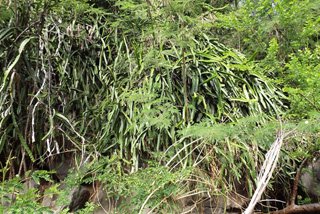 Whatever, let us step forward and go check this vine falling down from a tall Schinus, the leaf shape is familiar but it is a little too far to be surely identified. Good guess! This woody climber is Argyreia nervosa, a powerful relative to Ipomoea genus, native to India and which has escaped in the wild since ages. It even becomes invasive in places, strangling limbs and covering tree tops hence suffocating them by lack of light and the added weight. Called 'silver liana' because of the downy silvery hairs growing on its underside it is also called 'Hawaiian Baby Wood-rose', often leading to a confusion with Merremia tuberosa, the 'true' wood-rose. Well, just like with Albizzia, fruits are healthy though still unripe but provide hope for out next trip here!
Whatever, let us step forward and go check this vine falling down from a tall Schinus, the leaf shape is familiar but it is a little too far to be surely identified. Good guess! This woody climber is Argyreia nervosa, a powerful relative to Ipomoea genus, native to India and which has escaped in the wild since ages. It even becomes invasive in places, strangling limbs and covering tree tops hence suffocating them by lack of light and the added weight. Called 'silver liana' because of the downy silvery hairs growing on its underside it is also called 'Hawaiian Baby Wood-rose', often leading to a confusion with Merremia tuberosa, the 'true' wood-rose. Well, just like with Albizzia, fruits are healthy though still unripe but provide hope for out next trip here!
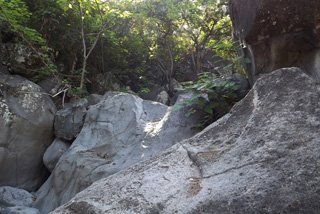 As we turn round to get deeper in the ravine we see a large stone slab absolutely covered with a huge Hylocereus undatus, it looks just like a struggle between rocky elements and living beings. This climbing cactus is native to dry areas of Central America and has largely escaped into the wild just like the other three species we have met so far in this rather short stroll. Invasive species is an important issue in places like Reunion, the place is small therefore seeds are easily propagated by the many birds. Now, this impressive cactus which can break down branches in trees though it produces a good deal of flowers does not set fruits. The reason for this is the need for cross-pollination, performed by bats. The poor aerial mammals have been hunted for food in former times and know suffer from sprays in the near-by sugar cane fields. But as it very easily propagates through cuttings, broken and fallen pieces do root easily on the spot thus forming large clumps. Not a bit fussy, the pitahaya crawls on trees and rocks all alike, no matter how hot the later ones get in summer !
As we turn round to get deeper in the ravine we see a large stone slab absolutely covered with a huge Hylocereus undatus, it looks just like a struggle between rocky elements and living beings. This climbing cactus is native to dry areas of Central America and has largely escaped into the wild just like the other three species we have met so far in this rather short stroll. Invasive species is an important issue in places like Reunion, the place is small therefore seeds are easily propagated by the many birds. Now, this impressive cactus which can break down branches in trees though it produces a good deal of flowers does not set fruits. The reason for this is the need for cross-pollination, performed by bats. The poor aerial mammals have been hunted for food in former times and know suffer from sprays in the near-by sugar cane fields. But as it very easily propagates through cuttings, broken and fallen pieces do root easily on the spot thus forming large clumps. Not a bit fussy, the pitahaya crawls on trees and rocks all alike, no matter how hot the later ones get in summer !
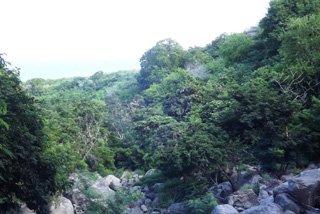 For now let us sit on this large slab and enjoy the view! I always relish at the sight of those bare black boulders sided by a short but lush vegetation. This Trou ravine is a rather dry one but I will someday take you to the neighboring one where there is a spring thus ponds and all the life surrounding it. Have a drink and we may proceed to get back down, on the way we can harvest some Ipomoea coccinea and I . obscura seeds, I spotted them just after the large volcano-shaped boulder we went by. Again, those vines are not native to Reunion but are found in any suitable biotope they find. Although not very showy due to the size of the corolla, those species are among many other ones I supply, either to enthusiast collectors or professional hybridizers. By the way, we have to stop on the road somewhere in the outskirts of Manapany so that I can check for Ipomoea ochracea, a nice yellow-flowered African species which I am regularly ordered.
For now let us sit on this large slab and enjoy the view! I always relish at the sight of those bare black boulders sided by a short but lush vegetation. This Trou ravine is a rather dry one but I will someday take you to the neighboring one where there is a spring thus ponds and all the life surrounding it. Have a drink and we may proceed to get back down, on the way we can harvest some Ipomoea coccinea and I . obscura seeds, I spotted them just after the large volcano-shaped boulder we went by. Again, those vines are not native to Reunion but are found in any suitable biotope they find. Although not very showy due to the size of the corolla, those species are among many other ones I supply, either to enthusiast collectors or professional hybridizers. By the way, we have to stop on the road somewhere in the outskirts of Manapany so that I can check for Ipomoea ochracea, a nice yellow-flowered African species which I am regularly ordered.
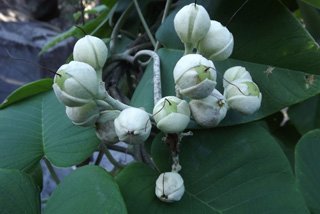 Back at the bridge, all those bits and pieces of woods you see at the mouth of the ravine are the witnesses as well as victims of past downpours and cyclones, some trunks are large enough to smash you on the way ! Now that we walk on the sand you can see still another vine crawling on the ground, Ipomoea pes-caprae (beach morning glory or goat's foot)which bears locally the name of 'patate à Durand', namely 'Smith's potato', for the resemblance of its leaves with those of Ipomoea batatas, the yam or sweet potato. Its thick and coriaceous leaves are very well adapted to the hot sand, sea-spray and fierce winds usual on this area.
Back at the bridge, all those bits and pieces of woods you see at the mouth of the ravine are the witnesses as well as victims of past downpours and cyclones, some trunks are large enough to smash you on the way ! Now that we walk on the sand you can see still another vine crawling on the ground, Ipomoea pes-caprae (beach morning glory or goat's foot)which bears locally the name of 'patate à Durand', namely 'Smith's potato', for the resemblance of its leaves with those of Ipomoea batatas, the yam or sweet potato. Its thick and coriaceous leaves are very well adapted to the hot sand, sea-spray and fierce winds usual on this area.
Well now, take off your shoes and put on flip-flops, we can walk a couple hundred yards and I will show you a secret basin hidden by the shore where we can take a refreshing swim before driving back.
Copyright © www.100flowers.win Botanic Garden All Rights Reserved